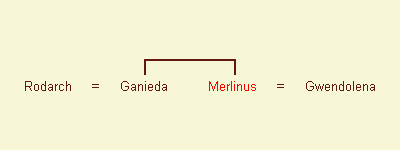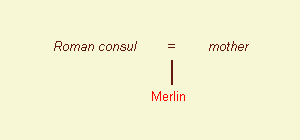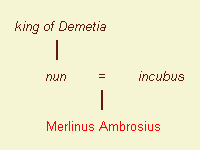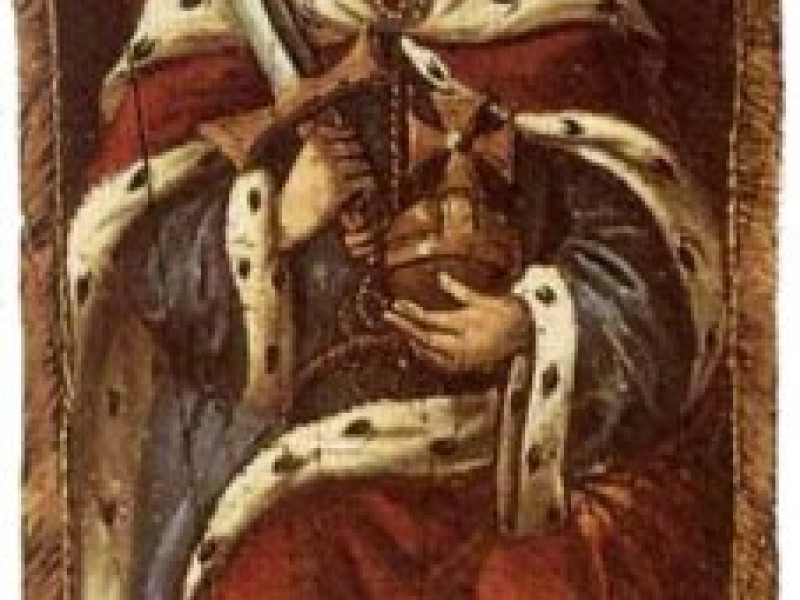Merlin
Wild Man of the Woods
The two different family trees, shown below, were derived from two different sources:
Various Welsh poems attributed to Myrddin, particularly in the Black Book of Carmarthen, c. 1250.
Vita Merlini, written by Geoffrey of Monmouth, c. 1150.
The Welsh Myrddin
There are number of poems that are attributed to Myrddin found in the Black Book of Carmarthen. From these poems I was able to derive the relationship between him and his sister Gwenddydd. Myrddin may have been responsible for the killing of his nephew, the son of Gwenddydd, in the Battle of Arfderydd.
It is from The Dialogue Between Myrddin and his Sister Gwenddydd preserved in the Red Book of Hergest, where I found the name of Myrddin's father and possibly his four brothers. Myrddin and Gwenddydd were said to be twins.
See the Welsh Legend of Myrddin.
Geoffrey's Caldonius Merlin
The source for the family tree of Caldonius Merlin came from Geoffrey of Monmouth's Vita Merlini, written in 1150 (see The Wild Man of the Woods). Geoffrey also wrote Historia regum Britanniae in 1137, in which Merlin first appeared as a boy and advised King Vortigern about his crumbling fortress walls. People have speculated that Geoffrey was writing about two different Merlins.
Geoffrey of Monmouth may have gotten his own sources from the Welsh poems attributed to Myrddin, and from the Scottish legend about Lailoken.
From Boy Prophet to Wizard
The three different family trees, shown below, were derived from three different sources:
Historia Brittonum, written by Nennius, 9th century.
Historia regum Britanniae, written by Geoffrey of Monmouth, 1137.
Merlin, written by Robert de Boron, 1200 (there is also a prose version of Merlin, which is part of the Vulgate Cycle, written in c. 1240).
Nennius' Ambrosius
This family tree is based upon the account in Historia Brittonum, which Nennius wrote in the 9th century. Geoffrey of Monmouth based his Historia regum Britanniae (c. 1137) upon Nennius' work, changing and elaborating on the event where Vortigern tried to build a fortress, but its walls kept tumbling down.
In Nennius' account, the "boy born without a father" was named Ambrosius, not Merlin. Ambrosius is actually a Roman name for Emrys. After Ambrosius (Merlin) told the king what was causing the walls to collapse, he claimed that his father was a Roman consul, compared with Geoffrey claiming the boy's father was the devil or an incubus.
See either the Boy Prophet or Vortigern about this event.
Geoffrey's Merlin Ambrosius
The genealogy above is based upon the Historia regum Britanniae, written by Geoffrey of Monmouth, in 1137. Geoffrey was the first to use the name Merlin (or Merlinus, since he had written the Historia in Latin).
He elaborated the scene, found in Nennius' Historia Brittonum (c. 9th century), about Vortigern trying to build a fortress which kept collapsing. It was in this scene that Vortigern met Merlin. Through his mother, Merlin was the grandson of the King of Demetia (Dyved). Merlin was the son of the devil (or incubus), but because of his baptism at birth, he had great wisdom and the remarkable ability to foretell the future. After Merlin finished explaining why Vortigern's fort kept collapsing, he revealed that his name was also Ambrosius.
See either the Boy Prophet or Vortigern about this event.
Geoffrey didn't give us much detail about Merlin's extraordinary birth. The next source was written by Robert de Boron, in his trilogy of verse romances about the Grail.
Boron's Merlin
Robert de Boron was a French poet who wrote a trilogy about the Holy Grail (c. 1200): Joseph of Arimathie, Merlin and Perceval.
It was in Merlin that Boron wrote an account about Merlin's birth. This poem also gave an account about the birth and fosterage of Arthur, and Arthur becoming king when he drew a sword out of an anvil or stone, but the account is fragmented. There is a prose version of Merlin, found in one of the five works of the Vulgate Cycle.
In that work, Merlin was indeed the son of the devil, but because his mother was a devout Christian, baptising her son immediately after birth, Merlin was not an evil creature of Satan. He retained his demonic power to know everything that had happened in the past, but he was also given God's gift to see the future.
We discovered that at birth, Merlin was named after his grandfather.
You will find an account about Merlin's birth in Timeless Myths, titled Son of the Devil?
Related Page
By Jimmy Joe













